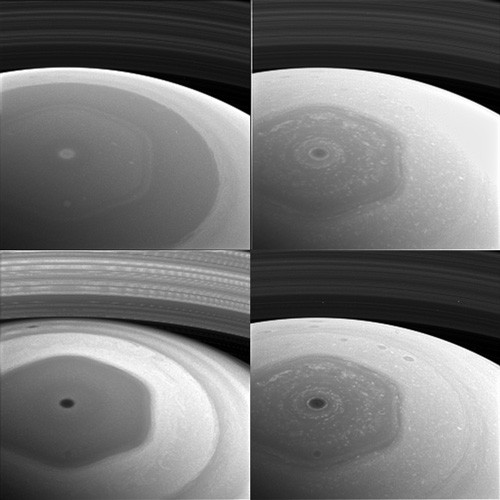By Ana Verayo, | December 08, 2016

This collage of images shows Saturn's northern hemisphere and rings as viewed with four different spectral filters. (NASA/JPL-Caltech/Space Science Institute)
NASA's Cassini spacecraft has sent some stunning images of Saturn's mysterious hexagonal storm on its north pole. This odd shape is caused by the gas giant's polar region's jet stream within this massive polar storm.
Like Us on Facebook
NASA's Saturn orbiter is currently on a mission to complete 22 flybys within the closest distance ever made by any man-made spacecraft to obtain the closest views of Saturn's majestic ring system.
This new image reveals the most detailed view yet of Saturn's northern hemisphere, captured by Cassini from 240,000 miles above the surface of the gas giant. The spacecraft's wide angle camera captured this new imagery while diving into Saturn's ring plane.
Within the eye of this colossal alien storm on Saturn's northern polar region lies smaller storms that are embedded within the hexagon shaped jet stream.
Using different spectra and filters for different wavelengths of light, this set of images of the storm provides crucial data for mission scientists such as cloud formations, hazes, and other weather systems on Saturn that also occur on different altitudes. The onboard camera of Cassini used filters ranging from violet, red to near infrared to infrared light.
Apart from this, Cassini's high-resolution camera will capture Saturn's rings during future dives as it grazes through its ring plane. The spacecraft will also hunt down and capture images of Saturn's elusive moonlets, namely Atlas, Daphnis, Pan, and Pandora, which have never been photographed before.
According to Cassini's imaging team head, Carolyn Porco of the Space Science Institute in Colorado, this is the beginning of the end of the historic mission of Saturn.
In April next year, Cassini will embark on its grand finale, as it conducts the first of its 22 dives around the 2,400 kilometer gap between Saturn and its innermost ring. When the mission ends, the spacecraft will then plunge into Saturn's atmosphere on September 2017.
-
Use of Coronavirus Pandemic Drones Raises Privacy Concerns: Drones Spread Fear, Local Officials Say

-
Coronavirus Hampers The Delivery Of Lockheed Martin F-35 Stealth Fighters For 2020

-
Instagram Speeds Up Plans to Add Account Memorialization Feature Due to COVID-19 Deaths

-
NASA: Perseverance Plans to Bring 'Mars Rock' to Earth in 2031

-
600 Dead And 3,000 In The Hospital as Iranians Believed Drinking High-Concentrations of Alcohol Can Cure The Coronavirus

-
600 Dead And 3,000 In The Hospital as Iranians Believed Drinking High-Concentrations of Alcohol Can Cure The Coronavirus

-
COVID-19: Doctors, Nurses Use Virtual Reality to Learn New Skills in Treating Coronavirus Patients







